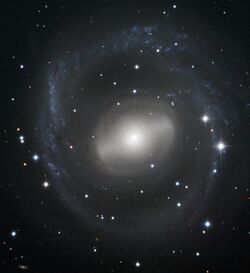Astronomy:NGC 2217
| NGC 2217 | |
|---|---|
 Credit:ESO | |
| Observation data (J2000 epoch) | |
| Constellation | Canis Major |
| Right ascension | 06h 21m 40.35s[1] |
| Declination | −27° 13′ 56.90″[1] |
| Redshift | 0.005400[2] |
| Helio radial velocity | 1619 km/s[2] |
| Distance | 73 Mly 22.4 Mpc[2] |
| Apparent magnitude (V) | 11.71[2] |
| Characteristics | |
| Type | (R)SB0+(rs)[2] |
| Apparent size (V) | 4.44 ′ × 4.84 ′[1] |
| Other designations | |
| MCG-05-15-010, PGC 18883[2] | |
NGC 2217 is a nearly face-on lenticular galaxy of about 100 thousand light-years across that lies roughly 65 million light years from Earth in the constellation of Canis Major. It is part of the NGC 2217 Group of galaxies. It is classified as a barred spiral galaxy.
A notable feature is the swirling shape of this galaxy. In its very concentrated central region we can see a distinctive, very luminous bar of stars within an oval ring. Further out, a set of tightly wound spiral arms almost form a circular ring around the galaxy.
Central bars play an important role in the development of a galaxy. They can, for example, funnel gas towards the center of the galaxy, helping to feed a central black hole, or to form new stars.[1]
One supernova, SN 2017fzw (type Ia, mag. 17.1), was discovered in NGC 2217 on 9 August, 2017.[3]
References
- ↑ 1.0 1.1 1.2 1.3 http://www.eso.org/public/images/potw1204a/ "ESO"
- ↑ 2.0 2.1 2.2 2.3 2.4 2.5 "NASA/IPAC Extragalactic Database". Results for NGC 2217. http://ned.ipac.caltech.edu/cgi-bin/nph-objsearch?objname=NGC+2217&extend=no&hconst=73&omegam=0.27&omegav=0.73&corr_z=1&out_csys=Equatorial&out_equinox=J2000.0&obj_sort=RA+or+Longitude&of=pre_text&zv_breaker=30000.0&list_limit=5&img_stamp=YES.
- ↑ Transient Name Server entry for SN 2017fzw. Retrieved 24 March 2023.
https://stardate.org/radio/program/2022-02-06
External links
Coordinates: ![]() 06h 21m 40.35s, −27° 13′ 56.90″
06h 21m 40.35s, −27° 13′ 56.90″
 |

